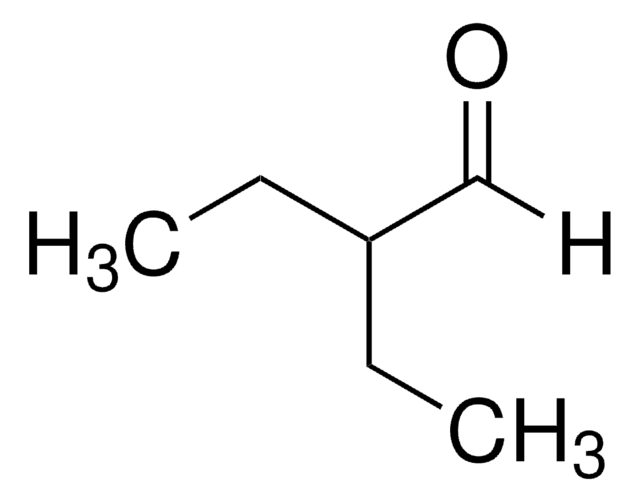E29109
2-Ethylhexanal
96%
Synonym(s):
2-Ethylcapronaldehyde
Sign Into View Organizational & Contract Pricing
All Photos(1)
About This Item
Linear Formula:
CH3(CH2)3CH(C2H5)CHO
CAS Number:
Molecular Weight:
128.21
Beilstein:
1700556
EC Number:
MDL number:
UNSPSC Code:
12352100
PubChem Substance ID:
NACRES:
NA.22
Recommended Products
Quality Level
Assay
96%
form
liquid
impurities
<4% 2-ethylhexanoic acid
refractive index
n20/D 1.415 (lit.)
bp
55 °C/13.5 mmHg (lit.)
density
0.822 g/mL at 25 °C (lit.)
SMILES string
[H]C(=O)C(CC)CCCC
InChI
1S/C8H16O/c1-3-5-6-8(4-2)7-9/h7-8H,3-6H2,1-2H3
InChI key
LGYNIFWIKSEESD-UHFFFAOYSA-N
Looking for similar products? Visit Product Comparison Guide
General description
2-Ethylhexanal is an aliphatic aldehyde used as an intermediate to produce various useful products such as perfumes, disinfectants, paints, warning agents, insecticides, and leak detectors.
Application
2-Ethylhexanal can be used as:
- A reductant in the Mukaiyama epoxidation of cis-cyclooctene.
- A reactant in the Horner-Wadsworth-Emmons reaction to synthesize cis-α,β-unsaturated amides.
- A starting material to synthesize 2-ethylhexanoic acid using manganese(II) acetate as a catalyst.
Signal Word
Warning
Hazard Statements
Precautionary Statements
Hazard Classifications
Flam. Liq. 3 - Repr. 2 - Skin Sens. 1
Storage Class Code
3 - Flammable liquids
WGK
WGK 1
Flash Point(F)
111.2 °F - closed cup
Flash Point(C)
44 °C - closed cup
Personal Protective Equipment
dust mask type N95 (US), Eyeshields, Gloves
Choose from one of the most recent versions:
Already Own This Product?
Find documentation for the products that you have recently purchased in the Document Library.
Customers Also Viewed
Heather L Voegtle et al.
Journal of chemical ecology, 34(2), 215-219 (2008-01-24)
E-2-ethyl-2-hexen-1-ol (1), mellein (4), and 4-hydroxymellein (5) were identified as the major volatile compounds in the head and/or thorax of Camponotus quadrisectus. Neither 1 nor 5 have been previously detected in insects. Also identified were small amounts of m-cresol (2)
Epoxidation using molecular oxygen in flow: facts and questions on the mechanism of the Mukaiyama epoxidation
Vanoye L, et al.
Catalysis Science & Technology, 6, 4724-4732 (2016)
Continuous catalytic ?one-pot? multi-step synthesis of 2-ethylhexanal from crotonaldehyde
Seki T, et al.
Chemical Communications (Cambridge, England), 3562-3564 (2007)
The effect of feeding di-(2-ethylhexyl) phthalate and related compounds on lipids in the laying hen.
D L Wood et al.
Poultry science, 63(3), 469-477 (1984-03-01)
Di-(2-ethylhexyl) phthalate (DEHP) and three structurally related side-chain analogs were fed to laying hens to determine relationships of structure to effects on lipid metabolism. Hubbard broiler breeder hens were fed either a standard laying mash control diet or the control
Factors affecting the selectivity of air oxidation of 2-ethyhexanal, an α-branched aliphatic aldehyde
Lehtinen C and Brunow G
Organic Process Research & Development, 4, 544-549 (2000)
Our team of scientists has experience in all areas of research including Life Science, Material Science, Chemical Synthesis, Chromatography, Analytical and many others.
Contact Technical Service













